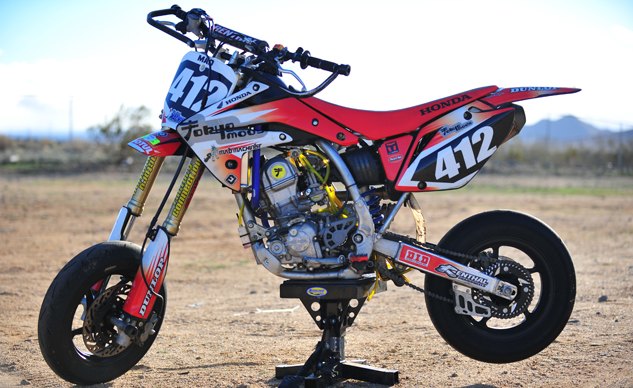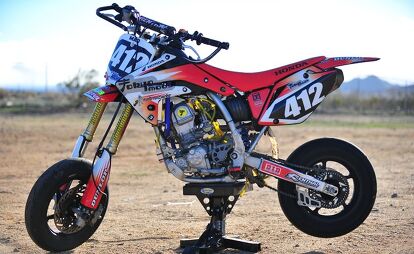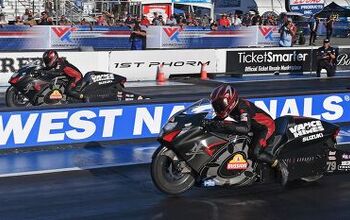Racing A Honda CRF150R Is Minibike Racing The Way It Should Be

This is the Honda MO should have raced all along!
If you’ve been following MO for a while then you might remember the tale of woe that was our experience racing a Honda Grom for 24 hours, wherein we obtained a Grom, ordered up a ton of parts for it (the monetary sum totalling more than the bike’s original cost), slapped them all on, and went straight to the racetrack the next day to race with our friends at the United Mini Racing Association (UMRA) with visions of glory. Instead, it took mere minutes to discover our “modified” machine was nearly unrideable, dashing our hopes for victory and killing our spirits in the process.
To add insult to injury, in the weeks following the race Ed Sorbo of Lindemann Engineering went to work trying to sort out the issues plaguing our troubled machine. A lot of progress was made, but it was all for nothing as the bike was crashed heavily during the UMRA season finale at Adams Motorsports Park when I swapped Groms with another rider.
As it turns out, there was a silver lining to the situation – and his name is Hans King. A fast dude in his own right (he won his race going away earlier in the afternoon), he happened to catch wind of my plight. Sympathetic to my situation, at the end of the day he turned to me and offered a ride on his bike – A Honda CRF150R. This was no ordinary 150R, mind you. This 150R was built by King’s friend Josh Vollmer, also known as The Mad Machinist.
Why the name? Because Vollmer stops at nothing in the quest for speed. A former fabricator for a number of auto and moto race teams, no stone was left unturned in the 150R build. He remained secretive about exactly what mods he made, but it is still the stock displacement of 149cc. After that, he admitted to having head work, an experimental camshaft, higher compression, high-capacity radiators, and carburettor mods – and that’s just the work he put in to the engine.
As for the rest of the bike, the suspension was re-valved and re-sprung for asphalt duty, the front brake disc was replaced with a ductile iron full-floating rotor and is clamped by a CRF450R front caliper with road race pads he had to make a custom bracket for. Fluid is transferred through steel-braided lines, of course. And then there are the wheels. Extensive modifications were done to fit the 12-inch wheels both he and King say offer better agility and less weight than the 17-inch wheels more commonly found in supermoto setups here in the States. “The mini-bike racing scene is huge in Japan and they use 12-inch wheels all the time,” King says.
With all those modifications thrown my way, my anticipation was sky high once I made it on the track. Luckily for me, my expectations were met. No, they were blown away. The combination of speed, accessible power, sublime handling and perfect braking were on full display at Adams and it put an instant grin on my face. I wondered why I didn’t just grab a CRF150R to race in the first place instead of a Grom. I didn’t need to take off my helmet for King to see my ear-to-ear grin.
“So you like it?” King asked. All I could do was nod my head. As it turns out, King and Vollmer have had the bike dialed thanks to the feedback of guys with names like Benny Solis, Joe Roberts, Chaz Davies, and Austin DeHaven – people you might know if you’ve paid attention at all to national and international racing. Impressive clientele, to say the least, and all I could ask in return was to have me ride the bike again sometime.
Fast forward a few months and King comes through on my wish. With UMRA holding a pre-season five-hour endurance race at Grange Motor Circuit at the end of January, King asks if I want to race it. The answer was obvious, but then he says, “Great! I’ll put you on a team with Benny Solis, Austin DeHaven, and Robert Perez. You’ll be Team Mad Labs.”
Now I’m a quick rider, but I’m junior varsity compared to the likes of those three. MotoAmerica Superstock 600 champ Joe Roberts was supposed to be another rider on the team, but contractual obligations meant he had to sit this one out. In the end, Solis wasn’t able to attend either, so King brought another fast local hotshot, Rafael DiSilva, to join us.
A Packed House
UMRA is gaining traction in the SoCal mini roadracing scene, and for its first event of its second season a whopping 30 entries signed up for the five-hour race. Mostly a mixture of NSR50s, Groms, and modified KX65 two-strokes, King’s CRF150 team of four heros and a journalist were the favorites. However, the one big question mark was the weather. Reports said rain was a certainty around 2pm, with chilly temps and high winds throughout. Without rain tires, all five riders would have to be mindful of the conditions.
To add a layer of complexity to the mix, King was going to ride a second Vollmer-built CRF150 with teammate Kuni Matsudaira, but fatigue got the better of him while prepping the main bike and he decided not to ride, leaving Matsudaira alone to ride the second bike. Since this was a preseason event with no points on the line, UMRA granted teams permission to ride different bikes. This meant DeHaven, Perez, DiSilva, Matsudaira and I were free to hop between the two Mad Labs 150Rs.
DeHaven and DiSilva each took a 150 to start the race with DeHaven jumping to the holeshot on the B bike and DiSilva right behind on the A bike. Wherever DeHaven went DiSilva followed, their sheer speed demonstrating to all that they were the class of the field. In fact by the half-hour mark the two lapped the KX65 in third place!
The plan was to jump to as big a lead as possible while the sun was shining, allowing us to coast once the rain hit. A few drizzles came and went, but it was nothing more than mental rain, the kind that spooks a rider but has little impact on grip. The bigger issue was the wind, as strong gusts were blowing all the bikes off line at times.
My first stint came at the 45-minute mark, taking over for DiSilva as the bike completely ran out of fuel as he exited the track towards the pits. With a full tank and a big lead, I set out just to have some fun before the impending rain. I was blowing past other bikes with ease, and the linear connection between my right hand and the rear tire made it easy to dial the exact amount of power I wanted. The suspension was setup on the softer side, making it a fun exercise in weight transfer when either on the gas or on the brakes. Eventually I could dial-in the exact amount of dive I wanted on the front simply from the squeeze I was putting on the brake lever. Trail braking directly to an apex was a piece of cake.
Honestly, I don’t remember much of my stint as the bike was working perfectly. The next thing I knew, I was getting the signal to pit. After the rider change and fuel up, I asked Mark Toons, King’s friend, fellow fast rider, and our pit help for the race how long I was out there for. “Forty-five minutes,” he said. “It felt like 15!” I replied, reminded that time really does fly when you’re having fun. Meanwhile the Mad Labs B bike was having carburettor issues, causing it to sputter and deliver power erratically. It was an issue that worsened throughout the race, eventually allowing first and second place positions to swap hands.
Down From The Heavens
No race is complete without at least a little bit of drama, and ours came during the fourth hour, which was just the time the skies turned ominously dark. As luck would have it, I was also up for my second stint. Knowing that my teammates built up a big lead precisely for this reason, my only goal was not to drop the bike. Within minutes of my re-entry into the race, droplets started forming on my visor. Mental rain I thought at first, until the droplets started gathering exponentially and my boot started gliding across the asphalt instead of dragging whenever I put it down.
I didn’t want to push too hard and risk a crash, nor did I want to slow too much for no reason. Thankfully, the hotshot riding the third place KX65 was on my tail and charging. I say thankfully because not half a lap after he came flying by me was he on the floor, his front tire tucking quickly as he asked for too much traction given the conditions. I knew then to dial back the speed, and as I passed the accident scene, thoughts of youth and exuberance vs. age and experience floated through my head. Had I really become that guy?
With my stint coming to an end and my goal of not falling achieved, I handed the bike off to Perez to take us to the checkered flag. The rain forced everyone to crawl, thus reducing our fuel consumption, meaning a quick splash was all Perez needed to get to the end. The rain also stopped by this point and a dry-ish line was forming, giving Perez a chance to let the bike sing again.
Within no time our five hours was up and Perez crossed the line to take the win, five laps ahead of the Mad Labs B bike and a whopping nine laps in front of third place. We might have been the overwhelming favorites to win the race, but victory is still sweet no matter what the odds.
I’d Rather Be Lucky Than Good
Imposter Syndrome: referring to high-achieving individuals marked by an inability to internalize their accomplishments and a persistent fear of being exposed as “fraud.” Despite external evidence of their competence, those exhibiting the syndrome remain convinced that they are frauds and do not deserve the success they have achieved. Proof of success is dismissed as luck, timing, or as a result of deceiving others into thinking they are more intelligent and competent than they believe themselves to be. – Wikipedia
You could say imposter syndrome applies to me in this case. Paired with the best bike on the grid and some supremely talented teammates, I just happened to be at the right place at the right time to take the win. Nonetheless, this was the mini racing experience I was hoping to have from the start of the Grom project – a bike that works flawlessly and puts a grin from ear to ear. The fact the MO Grom was a bust and the Mad Labs CRF150R is a success is testament to the fact that throwing parts at a bike means nothing without development. One lap aboard one of Vollmer’s CRF150Rs and it’s obvious the man known as the Mad Machinist won’t stop until the bike is perfect. Thanks for the opportunity, guys!

Troy's been riding motorcycles and writing about them since 2006, getting his start at Rider Magazine. From there, he moved to Sport Rider Magazine before finally landing at Motorcycle.com in 2011. A lifelong gearhead who didn't fully immerse himself in motorcycles until his teenage years, Troy's interests have always been in technology, performance, and going fast. Naturally, racing was the perfect avenue to combine all three. Troy has been racing nearly as long as he's been riding and has competed at the AMA national level. He's also won multiple club races throughout the country, culminating in a Utah Sport Bike Association championship in 2011. He has been invited as a guest instructor for the Yamaha Champions Riding School, and when he's not out riding, he's either wrenching on bikes or watching MotoGP.
More by Troy Siahaan








































































Comments
Join the conversation
It's certainly nice to ride a well-sorted bike, but those garcons in the French street race prove that you can race anything.
Could you tell us your Dry lap times vs the really hot guys. Like if you raced them and they had semi-standard CRF; would you be faster?